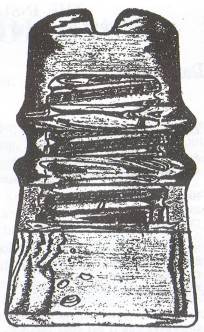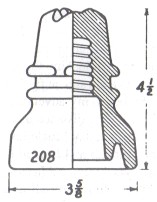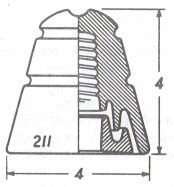Searching the A.T.&.T. Northern Transcontinental Toll Lead
by Mark Heitman
Reprinted from "Crown Jewels of the Wire", June 1992, page 18
The Stampede Pass Trips from 1978 to 1983
Part A
The Northern American Telephone and Telegraph Lead from Chicago to the
Pacific Northwest was placed in 1926 and 1927. It's mileage on the first
generation lead was 2,235 miles. It existed until the late 1950's to the mid
1960's. Somewhere between Spokane and Seattle the line split into two
separate toll leads.
My belief is one fed the Seattle and northwestern
Washington areas, as this lead went through Wenatchee to Seattle. The other fed
Tacoma and southwestern Washington, as this lead went through Ellensburg and
over Stampede Pass to Tacoma.
I first learned of the Stampede lead in 1978. At
that time I had been collecting insulators for about two years. I was currently
an installer/repairman for the Pacific Northwest Bell Telephone Company. I came
into work on a Friday morning, it was overcast and drizzly that day and it was not a real nice day to do installs. I reached into my pigeon
hole for my route sheet and guess what? We're going to the beach today. My first
stop would be the Ocean Shores Central Office to do my wire work before setting
out to do my orders. This work involves actually wiring up one's number to a
group and terminal for power and then to one's actual cable pair leaving the
office.

After completing this work I set out down the A Lead to my first order.
It was about four miles north of Ocean Shores at Ocean City. Upon reaching my
first install, I noticed that the residence had some very unusual looking
insulators in the front yard. They had crosses on the tops of them. I'd never
seen an insulator of this kind. Wow!! It could pour down rain all day if I could
get one of these for my collection. After chewing the fat with the older
gentleman about where he wanted his phone service installed, I learned he had
just retired as a Lineman out of Seattle for P.N.R. I told him of my
interest in collecting insulators and inquired if he would like to sell or
part with any of his insulators that he had in his front yard. This he declined,
but he said if I wanted to get some to go to Stampede Pass.
He began to tell me
of the Stampede Pass Toll Lead which he helped wreck. He said that they wrecked
it out in 1965 and 1966. A crew went from Tacoma east to the top of Stampede
Pass, and another crew went from Spokane west to the top of Stampede Pass. He
said the line went through the Tacoma Watershed to Lester, Washington. Then it
went up the west side of Stampede next to the Railroad Telegraph Lead. He told
me to go east of Lester and start looking. He said, "It's pretty remote
country so we threw insulators, crossarms and the works into the brush. The only
thing that we brought out was the copper open wire." One other thing that
he warned me of was the Watershed. "It is patrolled and don't go in there,
It's a $500 fine if they catch you in there." After all of the information
he gave me, I told him thank you, and would give it a shot at finding the lead.
So began my adventures of hunting a real long distance transcontinental. The
next day I fueled up my 1976 Chevy pickup and headed out to find Lester,
Washington. After about 3 hours of travel, I found myself in downtown Lester.
Expecting to see a thriving railroad and logging community, I blinked my eyes
and almost drove right passed the place. I only stopped at the west end of
Lester because I ran into the Watershed signs warning of No Trespassing. And
like the retired lineman had told me, they strictly said "KEEP OUT"
in no uncertain terms.
Well, I figured this must be downtown Lester. Man, what a letdown. Six small
dilapidated houses, one rundown sawmill, and one real neat looking old railroad
station right in the middle of this whole rundown mess. I drove around for about
a half an hour but no transcon. Thinking about what the lineman had told me
about it being next to the railroad telegraph line, I thought I might have
better luck at finding the lead up on Stampede rather than down here in Lester.
Knowing mountain passes like Snoqualmie Pass in Washington and Lookout Pass in
Montana, I knew that these areas are usually pretty narrow where they cross a
mountain range. This I hoped would give me an advantage at locating the
transcon. So back up the west side of the pass I went until I came to a nice
overlook where I could see the whole west side of Stampede. After about 10
minutes of scanning the mountains, I spotted an open wire lead going up the west
side. I thought this has to be the Railroad Telegraph Lead. It was the only
open wire lead in the area. So down a few dusty logging roads I went in search
of the lead. After about a mile of travel down one of the roads, I found myself
directly underneath the telegraph lead. Boy, was I getting "antsy"
now. I searched around for a while and my wisdom paid off. About 50 feet south
of the existing lead I found the base or butt of one of the cutoff transcon
poles. I knew it had to be a transcon pole by the types of broken glass that
surrounded the butt. I noticed there were broken Pyrex CD 128's, one CD 121
toll, a Hemingray CD 154, and several broken Whitall Tatum CD 154's in aqua and
one in peach. These were all strictly telephone lead type glass, as the railroad
lead had CD 214's and CD 162's on it. I worked my way down the west side and after searching
around 2 or 3 poles, I finally found the remains of a broken CD 141 ("straight-up")
crosstop and a lot of broken Hemingray 44 crosstops. I continued down a trail
cut by a railroad bulldozer to make a fire trail for their lead, and had gone
down about 2 more poles when right smack dab in the middle of one of the cat
tracks was part of a "straight-up". One section of the four-sectioned
top of the insulator was sticking out of the shale and clay dirt. I reached down
to pull it out but no-good, it wouldn't budge from it's hard compacted grave. I
painstakingly dug a 4-inch trench about 12 inches around the visible piece of
glass. After 'that I gently removed the clay dirt and shale rocks until I
removed a Mint Emerald CD 141. Not having the tools that I now use, it took me
about 20 minutes to remove the beautiful elusive cross-top. Boy, was I happy!
But, I suggest not doing this with a 3-inch pocket knife! The amazing thing is
that the cat pushed the insulator straight down without damaging any pat of the
piece with the cat's massive weight.
To take a brief break from the story, I
talked with Win Trueblood, one person I consider to be probably one of the most
knowledgeable people on Stampede hunting. He informed me that he has dug several
pieces in this very same manner. Not very many are found this way any more,
because the area has really been scoured by other hunters and Mother Nature has
really done her share at burying what is remaining. Win and a couple of other
hunters did get lucky at hunting in the summer of 1991.
Win was in an area not
far from here and had searched it pretty thoroughly before and couldn't figure
out why 2 poles didn't have any glass around, not even any broken pieces. So he
decided to take the boys and do a little more searching. Win and the boys dug
for 5 hours before they found any CD 141's. These they found under 3 feet of a
cat side spoils. One really has to dig to find any 141 's today. One thing about
Win is he's probably one of the most serious and meticulous hunters I know. In
the words of fellow collector, Dave Moffatt, "You know when Win has been
there because it looks like a D-9 cat when through" And Dave's right, Win
really tears up the dirt.
Meanwhile back to the Stampede story....on that day I
came out with the CD 141, one nice light lemon yellow Pyrex CSA, one Brookfield
green CD 208 cross-top, five Hemingray 44 CD 208's and a nice lime green
McLaughlin CD 122.

CD 208
The next trip to Stampede took me about 2 miles more west of the first
location. The area didn't produce much in the way of cross-tops as did the first
trip; just a lot of ordinary stuff except for a CD 211 No-Leak D insert. This
really excited me.
Shortly after this trip I met Andy and Violet Brown. I told them of my
Stampede adventure. After chewing the fat about Stampede for awhile and learning
that they too had many many trips to the line, Andy came out and showed me the
whole No-Leak D insulator complete with the insert ring. I'd never seen the
whole insulator or a whole ring, as I only had about one third of a ring that I
had found.

CD 211 No Leak D with insert
Then Andy decided to really fuel me up and came out with two more real nice
beauties. A CD 208 California in a nice smoky purple and a CD 208 California in
a nice golden yellow. The yellow was missing about 1/4 of the top section. Boy,
was I excited! I was ready to dig up the whole line from Lester to Chicago!
Andy and Vi told me horror stories from the late 1960's and very early 1970's when
they used to pull purple California 20S's right off the arms and enough 141 's to
fill up the front end of my truck! The next week we arranged to meet at Andy and
Vi's to go digging in the No-Leak territory. I took Andy and Vi to the spot where I had found my third of a ring and to my surprise, only
two weeks after I had dug it, a friend was with Andy and Vi in the same area and
had dug a whole No-Leak minus the ring only about 10 feet from where I found my
part of the ring. That day Andy and Vi got about six Hemingray 44's and I got
skunked. But to be shown how to dig and seeing how happy they were at their finds
for one day, made me feel good even though it was depressing when one comes out
empty-handed. It's like a saying in the Milholland book..."one shouldn't
become discouraged after searching around the bases of a few pole and finds
nothing. That next pole might just be harboring that rare beauty that you're
looking for."
That's really true, most of the time one's luck is 25% in
favor of decent glass and about 75% of getting skunked or getting regular junk.
Finding really fantastic stuff now is only about less than 5% ...at least on
this transcontinental line.
Later at Andy and Vi's home, they told me of another
pretty good area for finding the cross-tops was the Cabin Creek area. This area
was a little hilly, but for the most part a lot flatter than the west side of
Stampede. On this side is located a small group of houses that were once used to
house families that worked at a nearby sawmill.
The first time I went to Cabin
Creek, a house had four whole stress cracked California purple CD 208's in the
window! BINGO!
(TO BE CONTINUED NEXT MONTH.....)
Drawings of CD 208 and CD 211 are used with permission of N.R. Woodward, The
Glass Insulator in America, 1988 Report, p. 78
| 